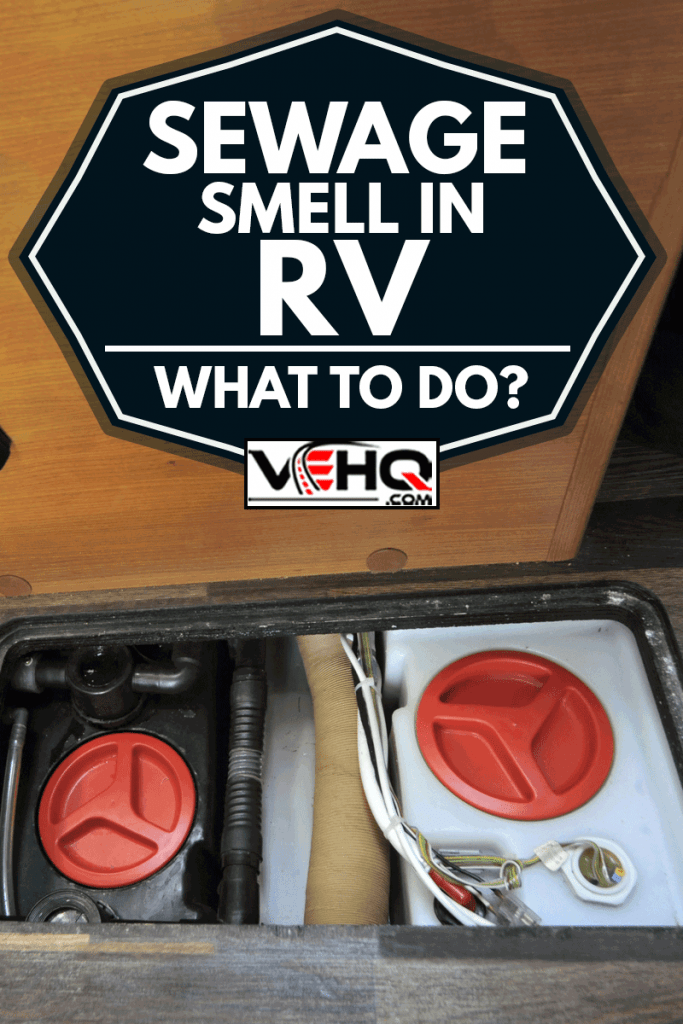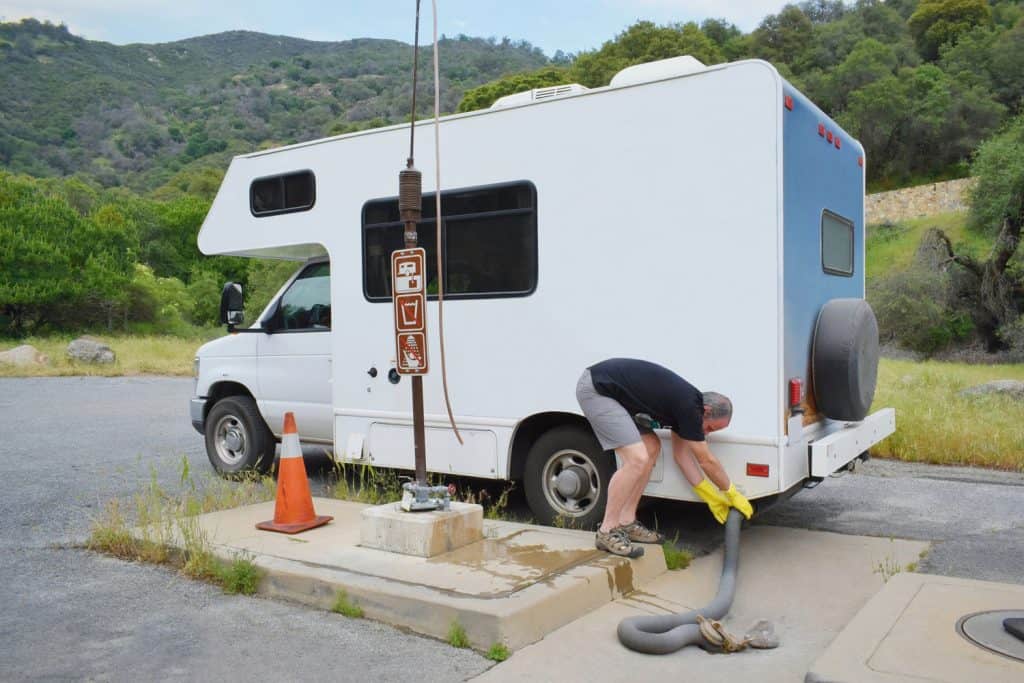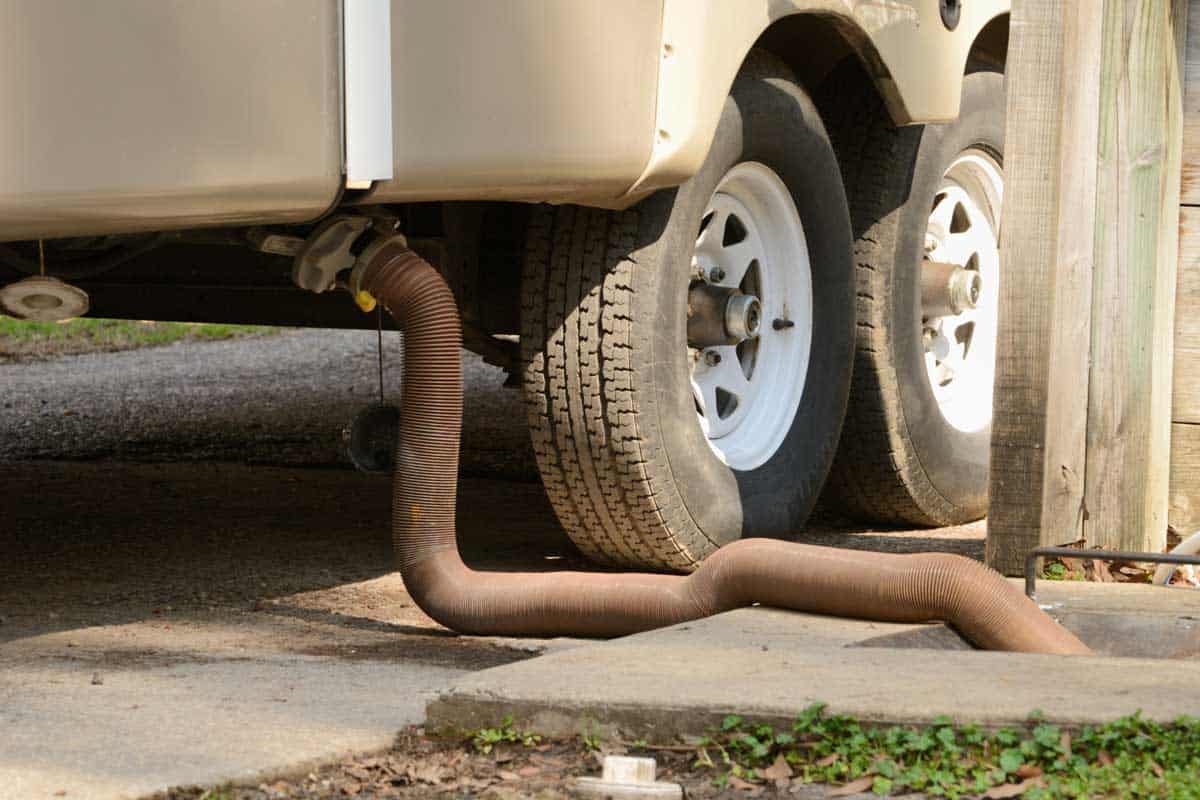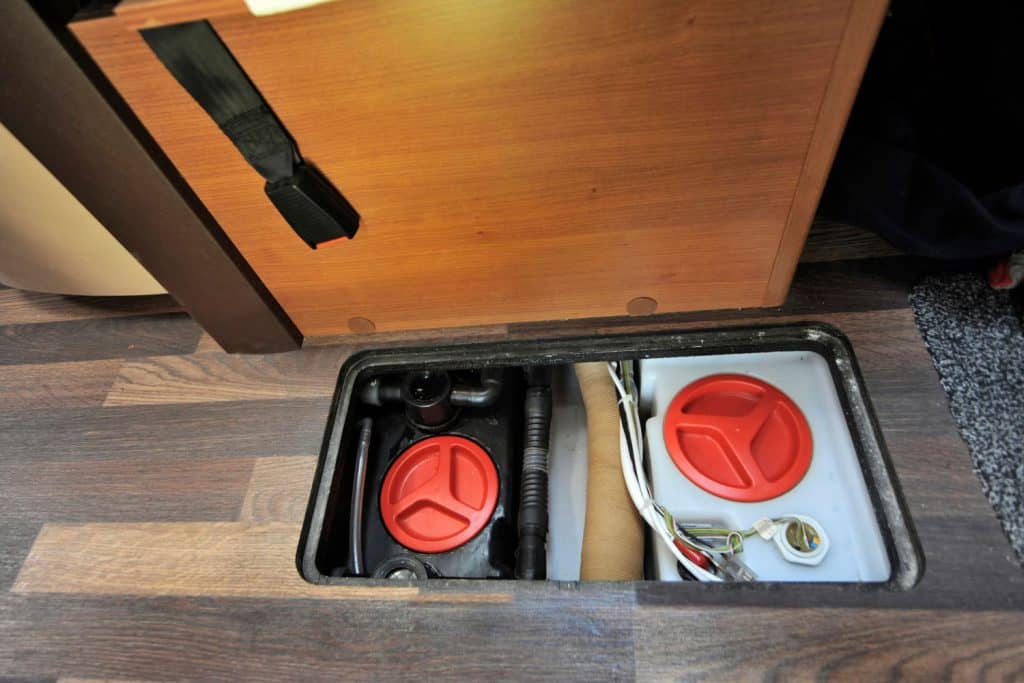So, you're on the road in your RV, driving to all those places you've always wanted to see, meeting interesting new people, and just generally enjoying the good life. But one evening, after a great day outdoors on a hiking trail, you return to your RV, open the door... and the smell of sewage hits you like a smack in the face. Yikes! This isn't so much fun anymore. Why is your RV suddenly smelling so bad, and what can you do to fix it? Don't worry -- we've done the research, and we have solutions for you!
There are several reasons why you may be smelling a sewage odor in your RV. Following are the most common issues and quick tips about how to fix them:
- Dirty toilet bowl or flapper: clean with an RV-approved cleaning solution
- Clogged toilet: pour a bag of ice into the toilet; then drive around, so the motion of the ice chips breaks up the clog
- Clogged vent pipe: insert a garden hose into the top of the vent pipe and run water into it until the clog is cleared
- Buildup of excrement on sides or bottom of tank: flush tank at an RV sanitation station
- High temperature (above 85 degrees): add water and a mineral-salt deodorizer
- Bad toilet flange or bowl seal: replace flange/seal
- Odor from P-trap in sink or shower: mix 1-gallon water with 1-cup baking soda and pour slowly down the drain
- Rotten egg odor from a clean water tank or faucets: mix 1-gallon water with 1-cup bleach and pour into 3/4-full clean water tank; let sit for 24 hours, then drain completely and refill the tank with freshwater
In the remainder of this article, we'll describe each of these problems in detail and give you specific step-by-step suggestions for remedying the issues. We'll also tell you how to maintain your black and gray water tanks, so you never get these odors again. And we'll answer several of the most common questions about dumping and cleaning your RV's black water tank. Keep reading to learn more!

How Do I Get Rid Of The Sewage Odor In My RV?

Below, we describe the issues that might cause your RV to smell like sewage. We also describe how to fix each of these issues.
Dirty Toilet Bowl Or Flapper
A common source of sewage odor in RVs is simply a dirty toilet or flapper. This typically occurs when you don't use enough water in flushing the toilet, so bits of solid waste and toilet paper remain adhered to the bowl and/or the flapper.
Fortunately, fixing this issue is easy: just scrub the bowl and flapper using a standard toilet bowl brush and a bacteria-based toilet cleaner designed for use in RVs. Don't ever use chemical cleaners in your toilet -- they will kill the bacteria that break down waste in your black water tank. After cleaning the dirty toilet or flapper, make sure you use more water with future flushes and leave enough water to cover the bottom of the bowl after each flush.
Click here for RV-safe toilet cleaner on Amazon.
Clogged Toilet
Another common issue is clogging in the toilet, which is usually the result of using too little water, flushing too much toilet paper, or attempting to flush larger items down the toilet. If the latter, you will need to fish the too-large item(s) out of the toilet's plumbing before cleaning up any residual clogging. If the clog consists only of excrement and/or toilet paper, there are a couple of options for clearing it:
Bag of Ice Trick
Buy a bag of ice, empty it into the toilet, and drive around for 20 to 30 minutes, allowing the ice chips' movement to break up the clog. Next, pour in a bacteria-based RV toilet drain opener to dissolve the clog. As the ice melts, it will carry the waste and the drain opener down into the black water tank.
RV Toilet Drain Opener
If your RV is already parked and stabilized, you may choose not to use the bag-of-ice trick. Instead, you can simply pour the RV toilet drain opener in and wait for it to work. After the drain begins to open up, flush it with water until the entire clog is gone.
Click here for RV-safe clog dissolving formula on Amazon.
Clogged Or Inadequate Vent Pipe
A sewage odor in your RV can also occur if the vent pipe that runs from your black water tank out through the roof of the RV is clogged. If the top of the pipe isn't well-protected, leaves or other debris can drop into the pipe and create a clog. To fix this problem, hook up a garden hose to a water source, climb to the top of your RV, and flush out the vent pipe by running water from the hose down through the pipe. Before you start this procedure, make sure your black water tank is empty enough to hold the additional water without overflowing.
Another potential issue arises if your RV is in motion. Your vent pipe experiences back-drafting, meaning the wind pushes gases back down into your black water tank instead of allowing them to vent out of the top of the pipe. If you smell sewer odor when driving but not when the RV is stationary, you may be experiencing this problem. You can solve it by purchasing and installing a special aerating vent pipe.
Click here for aerating vent pipe on Amazon.
Buildup On Sides Or Bottom Of Black Tank
When your RV smells like sewage, the most common issue is that your black water tank has waste buildup on its sides and/or bottom. This typically occurs because there is not enough water in the tank because you aren't using enough water when you flush, your black tank valve is open, or your black tank has a leak. The solution is to thoroughly flush out your black water tank at an RV sanitation station or similar facility. During the flushing procedure, examine your tank thoroughly for leaks; after flushing, make sure you close the valve on the black water tank.
To prevent this issue from recurring, follow these guidelines for maintaining your black tank:
- Empty the black water tank every three to five days.
- Every fifth time you empty the tank, flush it for 20 to 30 minutes using a tank rinser, external tank flusher, or tank flushing wand.
- Twice per year, deep-clean your black water tank.
Click here for RV black tank flushing wand on Amazon.
High Temperatures
When the temperature outdoors gets too high, your black water tank may get so warm that it begins emitting foul odors. Take two steps to solve this problem. First, flush the toilet a couple of times, holding the pedal down for at least ten seconds to put more cool water into the black tank. Second, use a mineral-salt deodorizing treatment to eliminate the odor. During long hot spells, empty your black water tank as often as you can.
Click here for hot-weather tank odor eliminator on Amazon.
Bad Toilet Flange Or Bowl Seal
The seals that keep your toilet from leaking will eventually wear out. This can allow waste and odors to escape. Inspect your toilet flange and bowl seals for cracking, hardening, and wear. If they appear to be impaired, replace them.
Click here for RV toilet bowl seal kit on Amazon.
Odor From P-Trap In Sink Or Shower
Not all sewage-type odors in your RV emanate from the toilet or black water tank. Your sink and/or shower can also produce unpleasant smells, especially if their P- or U-traps are malfunctioning. These traps are curved plumbing pipes, located just beneath the sink or shower drain. They trap and hold a small amount of water, serving as a barrier to keep noxious gases from coming up from the gray water tank into the RV.
To keep your gray water tank smelling clean, you can treat it with an odor-control formula like the one shown below. After treatment, run a small amount of water down the drain to ensure that your P- or U-trap is filled with clean water.
Click here for RV gray water odor control formula on Amazon.
Rotten Egg Odor From Fresh Water Supply
Occasionally, your fresh-water tank and/or the water inside it may become contaminated and give off a sulfur-like odor when you open a faucet. If this happens, it's important to clean the tank and fill it with fresh water, using the following steps:
- Open your fresh water taps and release water until the fresh water tank is 3/4 full.
- Mix 1-gallon of water with 1-cup of bleach (or use a cleaning solution like the one shown below).
- Pour this mixture (or solution) into your 3/4-full fresh water tank.
- Drive your RV around for 10 to 15 minutes so that the motion of the vehicle will cause the solution to mix thoroughly with the water in the tank.
- Leave the mixture and water in the tank overnight.
- Open the taps and completely drain the fresh water tank.
- Close the taps and refill the fresh water tank.
- Re-open a faucet and let it run until you no longer smell bleach in the water that's coming out.
After you take these steps, your fresh water tank will be clean and ready to use again!
Click here for RV fresh water tank cleaner on Amazon.
Maintenance Tips for Black And Gray Water Tanks
To keep your RV's black and gray water systems from smelling bad, follow these care-and-maintenance guidelines:
- Fill the toilet bowl with water before using the toilet.
- When you flush the toilet, hold the flush pedal down for 10 seconds or more.
- While the RV is parked, keep a few inches of water covering the bottom of the toilet bowl.
- Use biodegradable RV toilet paper.
- Never clean the toilet, shower, or sinks with chemical-based cleaners; they will kill the bacteria in your holding tanks. Use bacteria-based cleaners instead.
- Keep the temperature of your black water tank below 85 degrees.
- Dump the black water tank every three to five days, at a minimum.
- After each dump, treat the black water tank with aerobic bacteria + enzyme formula.
- After each dump, add enough water to the black tank to completely cover the bottom of the tank.
- Always keep the black water tank valve closed unless you are emptying the tank.
- After every fifth dumping of the black water tank, flush the tank thoroughly for 20 to 30 minutes.
- Deep clean the black water tank twice per year.
- Minimize the amount of grease that goes into the gray water tank.
- Deep clean the gray water tank every 5-10 dumps.
- Use high-quality enzyme-based dish soap.
Can You Hook Up An RV To A House Sewer?
You can save money on dumping your gray and black water tanks if you have access to a home that's hooked up to a municipal sewage system. Simply locate the cleanout valve located in the yard outside the house; then open the valve, hook your black water tank's dumping hose to the cleanout, and open the valve on your black water tank. This will allow the tank's contents to empty into the cleanout valve and thus into the municipal sewer system. Repeat the process with your gray water tank.
If your home has its own septic system with a cleanout valve, follow the steps listed above to empty your black and gray water tanks into the septic tank. If your septic system does not have a cleanout valve, you can install a PVC pipe, 4-inches in diameter. The capped top sticks up about 6-inches from the ground, and the bottom end empties into the septic tank. When you are ready to empty your RV's black and gray water tanks, simply uncap the pipe, hook up your dumping hose, and proceed as described above.
How Often Do You Have To Dump RV Sewage?

You should dump your black and gray water tanks when they're about 2/3 full. If you are traveling with a number of people in your RV, this may mean dumping your sewage every one or two days. For one or two people, you will probably dump every five or seven days. The average RV owner dumps the black and gray water tanks every three to five days. In order to avoid the hassle of dumping and cleaning the black water tank so often, some RV owners choose to use truck stops and restaurants for their toileting.
How Much Does It Cost To Dump RV Tanks?
The cost to dump your RV tanks ranges from $10 to $25; this price usually includes emptying and flushing the gray and black water tanks. If you spend much of the year traveling in your RV, you may want to consider purchasing an RV club membership that allows you to dump and clean your tanks at specified truck stops and/or RV campsites without paying additional fees. The cost of these memberships ranges from $200 to $1500 per year, depending on the amenities included.
Where Can You Dump Your Black Tank?
So, what happens if you need to dump your black water tank but you're not scheduled to camp at an RV park and there are no state parks within driving distance? It's time to get creative! Actually, there are a number of different places where you can take care of emptying your tanks. They include:
- RV parks and campgrounds
- Gas stations and truck stops that have RV dumping stations
- State and national parks
- Some municipal parks
- Marinas (boats also have black water tanks that need to be emptied)
- Recycling centers
- RV dealerships
- Sporting goods stores (call first to ask whether they have RV dumping facilities)
- Wastewater treatment plants
- Homes that have cleanout valves and are on municipal sewer systems
- Homes with private septic systems
How Often Should You Flush Your Black Tank?
You should thoroughly flush your black water tank every fifth time that you empty it. For the average RVer, that means every 15 to 25 days. After flushing it, pour a bacteria-based tank treatment formula down your toilet. This will keep buildup from forming on the sides and bottom of your tank.
Click here for black water tank treatment on Amazon.
In Closing

Foul odors in your RV can turn a much-anticipated vacation into a smelly nightmare. Fortunately, most of the issues that cause your RV to smell like sewage are relatively easy and inexpensive to fix. And, by maintaining and caring for your waste disposal system before problems arise, you can keep your RV smelling clean and fresh throughout your travels!
You may also enjoy:










We had our first hiccup, son hooked up black tank clean out to oncoming hose, yes you guessed it overflowed into the RV. How can I make sure I got all the stinky mess cleaned up and won’t have a stinky smell when we go back to the RV next week???
smell in RV is a big problem. this is very disgusting and dirty. You shared the great article. i read it fount this very informative. and i followed your methods to get rid of this amell. thank you for sharing this.